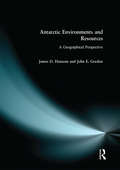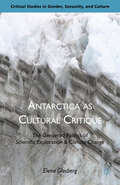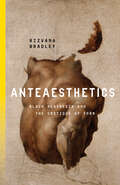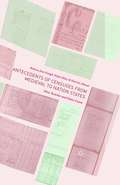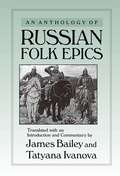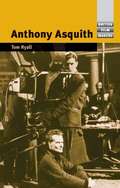- Table View
- List View
The Ant Trap: Rebuilding the Foundations of the Social Sciences (Oxford Studies in Philosophy of Science)
by Brian EpsteinWe live in a world of crowds and corporations, artworks and artifacts, legislatures and languages, money and markets. These are all social objects - they are made, at least in part, by people and by communities. But what exactly are these things? How are they made, and what is the role of people in making them? In The Ant Trap, Brian Epstein rewrites our understanding of the nature of the social world and the foundations of the social sciences. Epstein explains and challenges the three prevailing traditions about how the social world is made. One tradition takes the social world to be built out of people, much as traffic is built out of cars. A second tradition also takes people to be the building blocks of the social world, but focuses on thoughts and attitudes we have toward one another. And a third tradition takes the social world to be a collective projection onto the physical world. Epstein shows that these share critical flaws. Most fundamentally, all three traditions overestimate the role of people in building the social world: they are overly anthropocentric. Epstein starts from scratch, bringing the resources of contemporary metaphysics to bear. In the place of traditional theories, he introduces a model based on a new distinction between the grounds and the anchors of social facts. Epstein illustrates the model with a study of the nature of law, and shows how to interpret the prevailing traditions about the social world. Then he turns to social groups, and to what it means for a group to take an action or have an intention. Contrary to the overwhelming consensus, these often depend on more than the actions and intentions of group members.
The Ant Trap: Rebuilding the Foundations of the Social Sciences (Oxford Studies in Philosophy of Science)
by Brian EpsteinWe live in a world of crowds and corporations, artworks and artifacts, legislatures and languages, money and markets. These are all social objects - they are made, at least in part, by people and by communities. But what exactly are these things? How are they made, and what is the role of people in making them? In The Ant Trap, Brian Epstein rewrites our understanding of the nature of the social world and the foundations of the social sciences. Epstein explains and challenges the three prevailing traditions about how the social world is made. One tradition takes the social world to be built out of people, much as traffic is built out of cars. A second tradition also takes people to be the building blocks of the social world, but focuses on thoughts and attitudes we have toward one another. And a third tradition takes the social world to be a collective projection onto the physical world. Epstein shows that these share critical flaws. Most fundamentally, all three traditions overestimate the role of people in building the social world: they are overly anthropocentric. Epstein starts from scratch, bringing the resources of contemporary metaphysics to bear. In the place of traditional theories, he introduces a model based on a new distinction between the grounds and the anchors of social facts. Epstein illustrates the model with a study of the nature of law, and shows how to interpret the prevailing traditions about the social world. Then he turns to social groups, and to what it means for a group to take an action or have an intention. Contrary to the overwhelming consensus, these often depend on more than the actions and intentions of group members.
Antagonistic Tolerance: Competitive Sharing of Religious Sites and Spaces
by Devika Rangachari Timothy D. Walker Robert M. Hayden Aykan Erdemir Tuğba Tanyeri-Erdemir Manuel Aguilar-Moreno Enrique López-Hurtado Milica Bakić-HaydenAntagonistic Tolerance examines patterns of coexistence and conflict amongst members of different religious communities, using multidisciplinary research to analyze groups who have peacefully intermingled for generations, and who may have developed aspects of syncretism in their religious practices, and yet have turned violently on each other. Such communities define themselves as separate peoples, with different and often competing interests, yet their interaction is usually peaceable provided the dominance of one group is clear. The key indicator of dominance is control over central religious sites, which may be tacitly shared for long periods, but later contested and even converted as dominance changes. By focusing on these shared and contested sites, this volume allows for a wider understanding of relations between these communities. Using a range of ethnographic, historical and archaeological data from the Balkans, India, Mexico, Peru, Portugal and Turkey, Antagonistic Tolerance develops a comparative model of the competitive sharing and transformation of religious sites. These studies are not considered as isolated cases, but are instead woven into a unified analytical framework which explains how long-term peaceful interactions between religious communities can turn conflictual and even result in ethnic cleansing.
Antagonistic Tolerance: Competitive Sharing of Religious Sites and Spaces
by Devika Rangachari Timothy D. Walker Robert M. Hayden Aykan Erdemir Tuğba Tanyeri-Erdemir Manuel Aguilar-Moreno Enrique López-Hurtado Milica Bakić-HaydenAntagonistic Tolerance examines patterns of coexistence and conflict amongst members of different religious communities, using multidisciplinary research to analyze groups who have peacefully intermingled for generations, and who may have developed aspects of syncretism in their religious practices, and yet have turned violently on each other. Such communities define themselves as separate peoples, with different and often competing interests, yet their interaction is usually peaceable provided the dominance of one group is clear. The key indicator of dominance is control over central religious sites, which may be tacitly shared for long periods, but later contested and even converted as dominance changes. By focusing on these shared and contested sites, this volume allows for a wider understanding of relations between these communities. Using a range of ethnographic, historical and archaeological data from the Balkans, India, Mexico, Peru, Portugal and Turkey, Antagonistic Tolerance develops a comparative model of the competitive sharing and transformation of religious sites. These studies are not considered as isolated cases, but are instead woven into a unified analytical framework which explains how long-term peaceful interactions between religious communities can turn conflictual and even result in ethnic cleansing.
Antarctic Environments and Resources: A Geographical Perspective
by John Gordon J. D. HansomAntarctica is no longer a 'pole apart'. From a scientific perspective, the Antarctic ice sheet, ocean and climate systems are intimately linked with the global climate and are now seen to be of international significance for understanding climate change. From an economic perspective, the Antarctic is perceived to have great potential as a source of marine resources although the extent of speculated mineral and hydrocarbon resources is unknown. From a conservation perspective, the continent of Antarctica represents the ideal image of unspoiled wilderness.Antarctic Environments and Resources is an accessible and timely new geography of the Antarctic which examines the differing and sometimes conflicting interests in the great southern continent, the Southern Ocean and the subantarctic islands against a background of the physical and natural systems of the region and their interactions. It charts the development of human involvement in the area, focusing on the exploitation of resources from early sealing to modern fisheries, tourism and science, and it assesses the consequent impacts on the natural environment. The text also reviews the emerging framework for future environmental management developed under the Antarctic Treaty System.This is an ideal text for undergraduates studying glacial geomorphology, environmental management, polar regions and the Antarctic.
Antarctic Environments and Resources: A Geographical Perspective
by John Gordon J. D. HansomAntarctica is no longer a 'pole apart'. From a scientific perspective, the Antarctic ice sheet, ocean and climate systems are intimately linked with the global climate and are now seen to be of international significance for understanding climate change. From an economic perspective, the Antarctic is perceived to have great potential as a source of marine resources although the extent of speculated mineral and hydrocarbon resources is unknown. From a conservation perspective, the continent of Antarctica represents the ideal image of unspoiled wilderness.Antarctic Environments and Resources is an accessible and timely new geography of the Antarctic which examines the differing and sometimes conflicting interests in the great southern continent, the Southern Ocean and the subantarctic islands against a background of the physical and natural systems of the region and their interactions. It charts the development of human involvement in the area, focusing on the exploitation of resources from early sealing to modern fisheries, tourism and science, and it assesses the consequent impacts on the natural environment. The text also reviews the emerging framework for future environmental management developed under the Antarctic Treaty System.This is an ideal text for undergraduates studying glacial geomorphology, environmental management, polar regions and the Antarctic.
The Antarctic Politics of Brazil: Where the Tropic meets the Pole
by Ignacio Javier CardoneThis book focuses on the connection between Brazil and Antarctica, two regions that can be seen as distant and contrasting, but are physically, culturally and politically associated. Relying on archival material and previous literature, the book offers a thorough account of Brazil’s involvement with one of the most significant regions in the global environment. The author explores the place of Antarctica in geopolitical works and in the first initiatives involving Brazil and the continent, from the rise of geopolitical thought in Brazil in the 1930s up to the present day. He argues that the connection between Brazil and Antarctica is not without its difficulties, but it has been structured in many enduring ways. The book covers causes for the delay and eventual adoption of a now active foreign policy regarding the region, the policy’s early performance in Antarctica, its evolution as a consequence of domestic and international changes, the increasing interest in the environment, and further recent developments.
Antarctica as Cultural Critique: The Gendered Politics of Scientific Exploration and Climate Change (Critical Studies in Gender, Sexuality, and Culture)
by E. GlasbergArguing that Antarctica is the most mediated place on earth and thus an ideal location for testing the limits of bio-political management of population and place, this book remaps national and postcolonial methods and offers a new look on a 'forgotten' continent now the focus of ecological concern.
Anteaesthetics: Black Aesthesis and the Critique of Form (Inventions: Black Philosophy, Politics, Aesthetics)
by Rizvana BradleyIn Anteaesthetics, Rizvana Bradley begins from the proposition that blackness cannot be represented in modernity's aesthetic regime, but is nevertheless foundational to every representation. Troubling the idea that the aesthetic is sheltered from the antiblack terror that lies just beyond its sanctuary, Bradley insists that blackness cannot make a home within the aesthetic, yet is held as its threshold and aporia. The book problematizes the phenomenological and ontological conceits that underwrite the visual, sensual, and abstract logics of modernity. Moving across multiple histories and geographies, artistic mediums and forms, from nineteenth-century painting and early cinema, to the contemporary text-based works, video installations, and digital art of Glenn Ligon, Mickalene Thomas, and Sondra Perry, Bradley inaugurates a new method for interpretation—an ante-formalism which demonstrates how black art engages in the recursive deconstruction of the aesthetic forms that remain foundational to modernity. Foregrounding the negativity of black art, Bradley shows how each of these artists disclose the racialized contours of the body, form, and medium, even interrogating the form that is the world itself. Drawing from black critical theory, Continental philosophy, film and media studies, art history, and black feminist thought, Bradley explores artistic practices that inhabit the negative underside of form. Ultimately, Anteaesthetics asks us to think philosophically with black art, and with the philosophical invention black art necessarily undertakes.
Anteaesthetics: Black Aesthesis and the Critique of Form (Inventions: Black Philosophy, Politics, Aesthetics)
by Rizvana BradleyIn Anteaesthetics, Rizvana Bradley begins from the proposition that blackness cannot be represented in modernity's aesthetic regime, but is nevertheless foundational to every representation. Troubling the idea that the aesthetic is sheltered from the antiblack terror that lies just beyond its sanctuary, Bradley insists that blackness cannot make a home within the aesthetic, yet is held as its threshold and aporia. The book problematizes the phenomenological and ontological conceits that underwrite the visual, sensual, and abstract logics of modernity. Moving across multiple histories and geographies, artistic mediums and forms, from nineteenth-century painting and early cinema, to the contemporary text-based works, video installations, and digital art of Glenn Ligon, Mickalene Thomas, and Sondra Perry, Bradley inaugurates a new method for interpretation—an ante-formalism which demonstrates how black art engages in the recursive deconstruction of the aesthetic forms that remain foundational to modernity. Foregrounding the negativity of black art, Bradley shows how each of these artists disclose the racialized contours of the body, form, and medium, even interrogating the form that is the world itself. Drawing from black critical theory, Continental philosophy, film and media studies, art history, and black feminist thought, Bradley explores artistic practices that inhabit the negative underside of form. Ultimately, Anteaesthetics asks us to think philosophically with black art, and with the philosophical invention black art necessarily undertakes.
The Antebellum Period (American Popular Culture Through History)
by James M. Volo Dorothy VoloThe Antebellum Era was a complex time in American culture. Young ladies had suitors call upon them, while men often settled quarrels by dueling, and mill girls worked 16-hour days to help their families make ends meet. Yet at the same time, a new America was emerging. The rapid growth of cities inspired Frederick Law Olmstead to lead the movement for public parks. Stephen Foster helped forge a catalog of American popular music; writers such as Washington Irving and Ralph Waldo Emerson raised the level of American literature; artists such as Thomas Cole and Thomas Doughty defined a new style of painting called the Hudson River School. All the while, schisms between northern and southern culture threatened to divide the nation. This volume in Greenwood's American Popular Culture Through History recounts the ways in which things old and new intersected in the decades before the Civil War.James and Dorothy Volo are one of the more prolific author teams in reference publishing today, and with this volume they make important contributions to Greenwood's successful series on America's other history.
Antecedents of Censuses from Medieval to Nation States: How Societies and States Count
by Dylan Riley Rebecca Jean Emigh Patricia AhmedAntecedents of Censuses From Medieval to Nation States, the first of two volumes, examines the influence of social formations on censuses from the medieval period through current times. The authors argue that relative influence of states and societies is probably not linear, but depends on the actual historical configuration of the states and societies, as well as the type of population information being collected. They show how information gathering is an outcome of the interaction between states and social forces, and how social resistance to censuses has frequently circumvented their planning, prevented their implementation, and influenced their accuracy.
The Antechamber: Toward a History of Waiting (Cultural Memory in the Present)
by Helmut PuffHelmut Puff invites readers to visit societies and spaces of the past through the lens of a particular temporal modality: waiting. From literature, memoirs, manuals, chronicles, visuals, and other documents, Puff presents a history of waiting anchored in antechambers—interior rooms designated and designed for people to linger. In early modern continental Western Europe, antechambers became standard in the residences of the elites. As a time-space infrastructure these rooms shaped encounters between unequals. By imposing spatial distance and temporal delays, antechambers constituted authority, rank, and power. Puff explores both the logic and the experience of waiting in such formative spaces, showing that time divides as much as it unites, and that far from what people have said about early moderns, they approached living in time with apprehensiveness. Unlike how contemporary society primarily views the temporal dimension, to early modern Europeans time was not an objective force external to the self but something that was tied to acting in time. Divided only by walls and doors, waiters sought out occasions to improve their lot. At other times, they disrupted the scripts accorded them. Situated at the intersection of history, literature, and the history of art and architecture, this wide-ranging study demonstrates that waiting has a history that has much to tell us about social and power relations in the past and present.
The Antechamber: Toward a History of Waiting (Cultural Memory in the Present)
by Helmut PuffHelmut Puff invites readers to visit societies and spaces of the past through the lens of a particular temporal modality: waiting. From literature, memoirs, manuals, chronicles, visuals, and other documents, Puff presents a history of waiting anchored in antechambers—interior rooms designated and designed for people to linger. In early modern continental Western Europe, antechambers became standard in the residences of the elites. As a time-space infrastructure these rooms shaped encounters between unequals. By imposing spatial distance and temporal delays, antechambers constituted authority, rank, and power. Puff explores both the logic and the experience of waiting in such formative spaces, showing that time divides as much as it unites, and that far from what people have said about early moderns, they approached living in time with apprehensiveness. Unlike how contemporary society primarily views the temporal dimension, to early modern Europeans time was not an objective force external to the self but something that was tied to acting in time. Divided only by walls and doors, waiters sought out occasions to improve their lot. At other times, they disrupted the scripts accorded them. Situated at the intersection of history, literature, and the history of art and architecture, this wide-ranging study demonstrates that waiting has a history that has much to tell us about social and power relations in the past and present.
Antenatal Midwifery Skills: Survival Guide (Nursing and Health Survival Guides)
by Alison EdwardsThis pocket-sized book, presented in an easy-to-follow format, is designed as a tool for students and professionals to carry in any setting, providing a quick reference guide to antenatal care and related anatomy and physiology. Used as a platform for wider reading, this text is an ideal reference point for any student or professional involved with the care of childbearing women.
Antenatal Midwifery Skills: Survival Guide (Nursing and Health Survival Guides)
by Alison EdwardsThis pocket-sized book, presented in an easy-to-follow format, is designed as a tool for students and professionals to carry in any setting, providing a quick reference guide to antenatal care and related anatomy and physiology. Used as a platform for wider reading, this text is an ideal reference point for any student or professional involved with the care of childbearing women.
Anteros: A Forgotten Myth
by Craig E. StephensonAnteros: A Forgotten Myth explores how the myth of Anteros disappears and reappears throughout the centuries, from classical Athens to the present day, and looks at how the myth challenges the work of Freud, Lacan, and Jung, among others. It examines the successive cultural experiences that formed and inform the myth and also how the myth sheds light on individual human experience and the psychoanalytic process. Topics of discussion include: Anteros in the Italian Renaissance, the French Enlightenment and English Modernism psychologizing Anteros: Freud, Lacan, Girard, and Jung three anterotic moments in a consulting room. This book presents an important argument at the boundaries of the disciplines of analytical psychology, psychoanalysis, art history, and mythology. It will therefore be essential reading for all analytical psychologists and psychoanalysts as well as art historians and those with an interest in the meeting of psychoanalytic thought and mythology.
Anteros: A Forgotten Myth
by Craig E. StephensonAnteros: A Forgotten Myth explores how the myth of Anteros disappears and reappears throughout the centuries, from classical Athens to the present day, and looks at how the myth challenges the work of Freud, Lacan, and Jung, among others. It examines the successive cultural experiences that formed and inform the myth and also how the myth sheds light on individual human experience and the psychoanalytic process. Topics of discussion include: Anteros in the Italian Renaissance, the French Enlightenment and English Modernism psychologizing Anteros: Freud, Lacan, Girard, and Jung three anterotic moments in a consulting room. This book presents an important argument at the boundaries of the disciplines of analytical psychology, psychoanalysis, art history, and mythology. It will therefore be essential reading for all analytical psychologists and psychoanalysts as well as art historians and those with an interest in the meeting of psychoanalytic thought and mythology.
An Anthology of Migration and Social Transformation: European Perspectives (IMISCOE Research Series #0)
by Anna Amelina Kenneth Horvath Bruno MeeusThe contributions of this book examine contemporary dynamics of migration and mobility in the context of the general societal transformations that have taken place in Europe over the past few decades. The book will help readers to better understand the manifold ways in which migration trends in the region are linked to changing political-economic constellations, orders of power and inequality, and political discourses. It begins with an introduction to a number of theoretical approaches that address the nexus between migration and general societal shifts, including processes of supranationalisation, EU enlargement, postsocialist transformations and rescaling. It then provides a comprehensive overview of the political regulation of migration through border control and immigration policies. The contributions that follow detail the dynamic changes of individual migration patterns and their implications for the agency of mobile individuals. The final part challenges the reader to consider how policies and practices of migration are linked to symbolic struggles over belonging and rights, describing a wide range of expressions of such conflicts, from cosmopolitanism to racism and xenophobia. This book is aimed at researchers in various fields of the social sciences and can be used as course reading for undergraduate, graduate and postgraduate courses in the areas of international migration, transnational and European studies. It will be a beneficial resource for scholars looking for material on the most current conceptual tools for analysis of the nexus of migration and societal transformation in Europe.
An Anthology of Russian Folk Epics
by James Bailey Tatyana IvanovaAn extensive introduction provides basic information about Russian epics, their historical background, their poetics, the history of their collection, their performance context, and their main interpretations. In addition, their is a short introduction to each song, explaining its plot, allusions, and interpretations. A glossary of common terms and a selected bibliography of studies about the Russian epic in English and Russian are also included in the volume.
An Anthology of Russian Folk Epics (Folklores And Folk Cultures Of Eastern Europe Ser.)
by James Bailey Tatyana IvanovaAn extensive introduction provides basic information about Russian epics, their historical background, their poetics, the history of their collection, their performance context, and their main interpretations. In addition, their is a short introduction to each song, explaining its plot, allusions, and interpretations. A glossary of common terms and a selected bibliography of studies about the Russian epic in English and Russian are also included in the volume.
An Anthology of Russian Folktales (500 Tips)
by Jack V. HaneyThis anthology gathers a broad selection of Russian folktales, legends, and anecdotes, and includes helpful features that make them more accessible and engaging for English-language readers. Editor Jack V. Haney has selected some of the best tales from his seven-volume "Complete Russian Folktale" collection and added examples of anecdotes and the long 'serial tales' told in the far north.The 114 tales included here represent every genre found in the Russian tradition. They date from the eighteenth through the twentieth centuries and come from all geographic regions of the Russian-speaking world. The collection is enhanced by a detailed introduction to the folktale and its types, brief introductions to each grouping of tales, head notes with interesting background for individual tales, and a glossary explaining Russian terms.
An Anthology of Russian Folktales (500 Tips)
by Jack V. HaneyThis anthology gathers a broad selection of Russian folktales, legends, and anecdotes, and includes helpful features that make them more accessible and engaging for English-language readers. Editor Jack V. Haney has selected some of the best tales from his seven-volume "Complete Russian Folktale" collection and added examples of anecdotes and the long 'serial tales' told in the far north.The 114 tales included here represent every genre found in the Russian tradition. They date from the eighteenth through the twentieth centuries and come from all geographic regions of the Russian-speaking world. The collection is enhanced by a detailed introduction to the folktale and its types, brief introductions to each grouping of tales, head notes with interesting background for individual tales, and a glossary explaining Russian terms.
Anthony Asquith (British Film-Makers)
by Tom RyallThis is the first comprehensive critical study of Anthony Asquith. Ryall sets the director's work in the context of British cinema from the silent period to the 1960s, examining the artistic and cultural influences which shaped his films. Asquith's silent films were compared favourably to those of his eminent contemporary Alfred Hitchcock, but his career faltered during the 1930s. However, the success of Pygmalion (1938) and French Without Tears (1939), based on plays by George Bernard Shaw and Terence Rattigan, together with his significant contributions to wartime British cinema, re-established him as a leading British film maker. Asquith's post-war career includes several pictures in collaboration with Terence Rattigan, and the definitive adaptation of Oscar Wilde's The Importance of Being Earnest (1951), but his versatility is demonstrated in a number of modest genre films including The Woman in Question (1950), The Young Lovers (1954) and Orders to Kill (1958).
Anthony Asquith (British Film-Makers)
by Tom RyallThis is the first comprehensive critical study of Anthony Asquith. Ryall sets the director's work in the context of British cinema from the silent period to the 1960s, examining the artistic and cultural influences which shaped his films. Asquith's silent films were compared favourably to those of his eminent contemporary Alfred Hitchcock, but his career faltered during the 1930s. However, the success of Pygmalion (1938) and French Without Tears (1939), based on plays by George Bernard Shaw and Terence Rattigan, together with his significant contributions to wartime British cinema, re-established him as a leading British film maker. Asquith's post-war career includes several pictures in collaboration with Terence Rattigan, and the definitive adaptation of Oscar Wilde's The Importance of Being Earnest (1951), but his versatility is demonstrated in a number of modest genre films including The Woman in Question (1950), The Young Lovers (1954) and Orders to Kill (1958).


